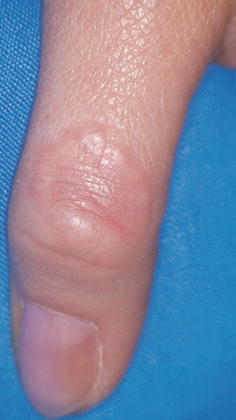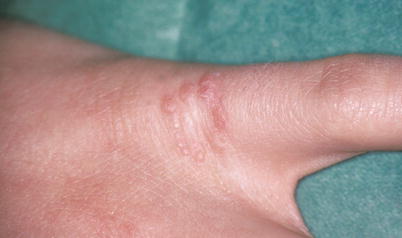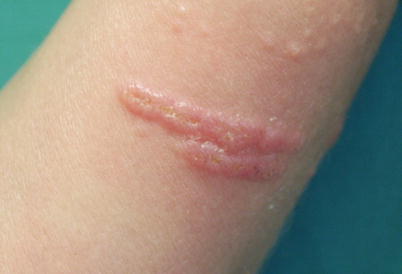(1)
Hôpital Universitaire de Strasbourg, Strasbourg, France
Abstract
Arrangement is the positioning of various lesions relative to each other, as opposed to configuration, which indicates the shape of an isolated primary lesion. Various types of configurations and arrangements are illustrated in Table 9.1. For example, a lesion may become annular by centrifugal extension of a single lesion (Fig. 9.1). Its configuration (shape) is then called annular. A lesion may also become annular through the confluence of different lesions which take the shape of a ring: This is called an annular arrangement (Fig. 9.2). In granuloma annulare, which is a dermatosis of unknown cause, both types of lesions described above may coexist. Linear arrangement is another type of particular arrangement (Fig. 9.3). Its underlying mechanisms as well as certain cases of linear dermatoses are illustrated in Table 9.2.
Arrangement is the positioning of various lesions relative to each other, as opposed to configuration, which indicates the shape of an isolated primary lesion. Various types of configurations and arrangements are illustrated in Table 9.1. For example, a lesion may become annular by centrifugal extension of a single lesion (Fig. 9.1). Its configuration (shape) is then called annular. A lesion may also become annular through the confluence of different lesions which take the shape of a ring: This is called an annular arrangement (Fig. 9.2). In granuloma annulare, which is a dermatosis of unknown cause, both types of lesions described above may coexist. Linear arrangement is another type of particular arrangement (Fig. 9.3). Its underlying mechanisms as well as certain cases of linear dermatoses are illustrated in Table 9.2.



Table 9.1
Arrangement and configuration
Arrangement of various lesions relative to each other | Configuration (shape of an individual lesion) |
|---|---|
Isolated | Discoid, nummular (Fig. 9.12) |
Grouped | Annular (Fig. 9.1) |
Clustered (cf. Fig. 2.2) | Arciform (incomplete ring) (Fig. 9.13) |
Agminated (lesions that are grouped in a specific anatomical area) (Fig. 9.5) | Target-shaped (Fig. 9.4) |
Corymbiform (lesions that are grouped around a central lesion) | Digitiform (finger-shaped) (Fig. 9.14) |
Annular (Fig. 9.2) | Linear (Fig. 9.3) |
Arciform (Fig. 9.6) | Stellar (Fig. 9.15) |
Petaloid (confluence of round, full lesions, as opposed to the annular confluence of round lesions with a healing center, producing polycyclic lesions) (Fig. 9.7) | Oval |
Polycyclic (Fig. 9.8) | Serpiginous (cf. Fig. 4.27) |
Linear (Fig. 9.9) | Reticulated (cf. Fig. 3.10) |
Serpiginous (cf. Fig. 4.25a) | Cribriform (forms a grid) (cf. Fig. 2.5) |

Fig. 9.1
Annular configuration. Granuloma annulare. Annular plaque on the back of the thumb, displaying a normal center and papular border, without alteration of the cutaneous surface. The cutaneous surface is unaltered, thus ruling out dermatophytosis, which is a highly prevalent annular dermatitis and usually has scaling borders (cf. Fig. 12.36). Granuloma annulare is an inflammatory skin disease of unknown cause

Fig. 9.2
Annular arrangement. Wart. Here, it is an annular arrangement and not a configuration. Indeed, the ring shape is produced by the confluence of several lesions. Compare with Fig. 9.1, where the lesion has an annular shape

Fig. 9.3




Linearity. Chemical burn by exposure to sodium hydroxide solution. Linearity almost always reflects an exogenous cause. In this example, the linear configuration is more important diagnostically than the primary lesion, which is a partially crusting, edematous plaque
Stay updated, free articles. Join our Telegram channel

Full access? Get Clinical Tree







